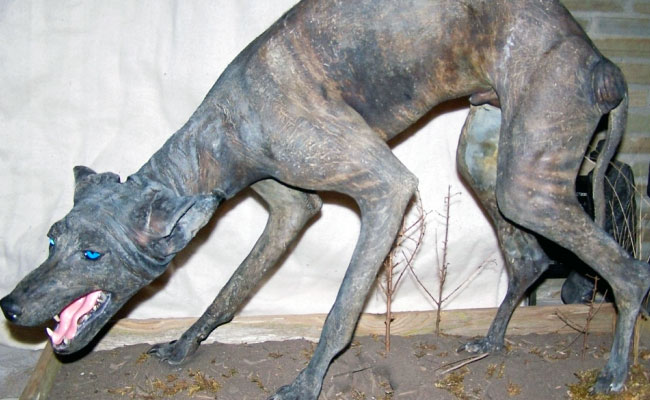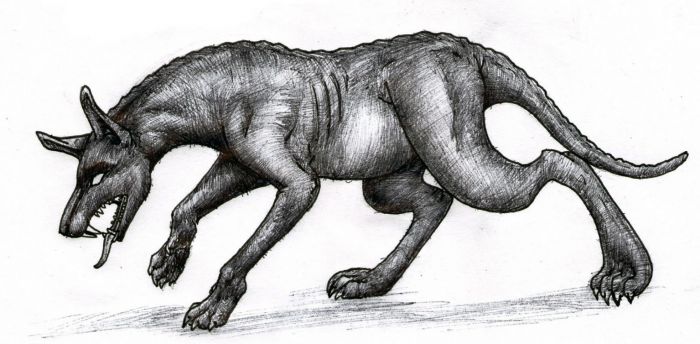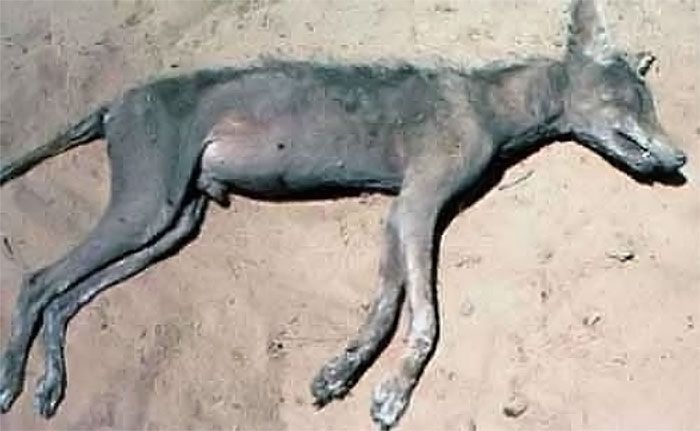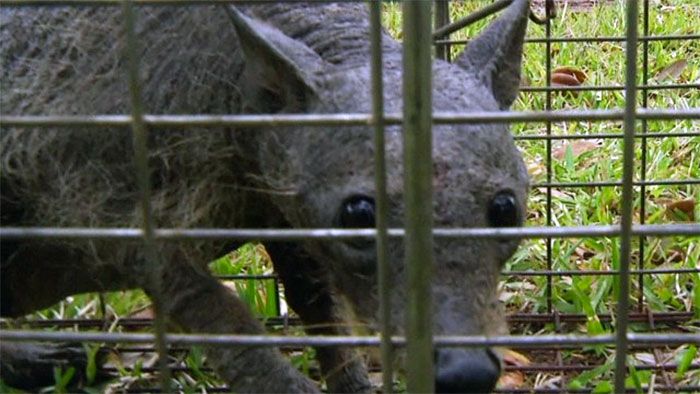
Chupacabra: The Most Convincing Stories
- By
- March 1, 2016
- September 30, 2021
- 13 min read
- Posted in
- Cryptozoology, Strange Beasts
Whilst to many people the term ‘Chupacabra’ might not mean anything, for many parts of the world it sparks the image of one of the most deadly creatures ever thought up. A creature of immense legend, the story of what constitutes a Chupacabra – or indeed if there is any truth to their potential existence – has changed many times over the course of history. In this simple guide, we’ll take a look at what makes the story so believable and why so many people have spent all these years discussing the unique legend of this creature.

A model of a Chupacabra
In this article, we’ll be trying to open the discussion on UFO Insight about the history of the creature and whether there might actually be something here worth discussing. Although to many the story and the mythology of the creature is simply unbelievable, some people swear by it. If you are unsure of what a Chupacabra is supposed to be then this will hopefully help you get some grounding on one of the most outrageous/terrifying stories that’s ever existed.
As far as legendary creatures go, few are more terrifying than this blight on nature. We’ll hopefully help people decide for themselves if this creature has any historical merit of whether it’s just another urban myth that has grown over the years. Try and come up with your own conclusion, and hopefully you’ll never meet one to confirm or debunk it!
Contents
So The Story Goes…
The main “history” of this unique creature is that it was a legendary creature which wandered various parts of the Americas. The most common “first sighting” of said beast was supposed to have come from the Puerto Rico region.
The name itself Chupacabra actually translates into “goat-sucker” in Spanish, and this is what it’s supposed to be so incredibly good at – appearing and wiping out livestock. Numerous unexplained deaths have been found in the past of animals which have been killed and had their blood sucked out of them entirely, left behind merely as a carcass dry of blood.
The most common meal for the Chupacabra, then, is the goat (as the name implies). The physical ideology of the creature depends on where you are from and who you listen to. Some say it was the size of a small grizzly bear, with spines from the neck to the base of its tail. Others picture it as something akin to an alien, an ET type creature with large bug-like eyes and claw-like hands.
The earliest “eye witness” reports come from 1995 in Puerto Rico, and since they have been heard in locations such as Chile, Maine and even in places like Russia!
However, the majority of the sightings tend to be limited in their credibility and usually turn out to be hoaxes or extremely circumstantial evidence. One common “sighting” has been a creature known as a candid, which has been inflicted by the mange condition – however, they tend to have varying styles depending on what culture you look into.

A sketch of a Chupacabra
Mistaken Issues
According to who you speak to and read, there are two different kinds of Chupacabra – one is a canid form, one is more of a reptilian nature. The creature itself has more than 2,000 alleged sightings across multiple countries so it’s hard to know if you are dealing with lots of different creatures or just lots of cultures using their own bogeymen stories and putting them into the one location. Regardless, there is more than one explanation for this unique creature depending on what parts of the world you go and read about.
However, in the majority of sightings in the USA, it’s put down to being weak coyotes that are beginning to struggle and are unable to go and take on “real” opposition, hence why they go for livestock. Another reason why this is so common is because Sarcopted scabiei, a parasitic condition that leaves animals with tougher skin and less fur, is common in the US.
In Mexico, the most common animal mistaken for a Chupacabra is the Mexican Hairless Dog. These are common misconceptions that people tend to make and ruin the accuracy of the sighting, meaning that a large chunk of Chupacabra stories from Mexico are discredited.
The first ever sightings which are recorded do come from Puerto Rico, as we mentioned above, and this causes a few issues. For example, the movie known as Species came out in 1995 and in that movie a creature which resembles the supposed Chupacabra exists in it. The creature which was described by the citizen as that it “looked like the Chupacabra”.
Does that limit the quality of her testimony?
Ever so slightly, you would imagine – according to Benjamin Radford, the author of 2011 book Tracking the Chupacabra, states that the eye witness, Madelyne Tolentino, believed that the events of Species were actually taking place around her.
However, this is not to say that we necessarily believe either side. We just wish to present the information as and when we can, with these important distinctions being very useful evidence.
The History
The first sighting is, as mentioned above, stated to be in March 1995. When eight sheep were found to be dead, all of them drained of blood entirely, alarms were raised. The investigation team found that each animal had strange puncture wounds on their chest, and eventually it was put down to the work of a rather nasty nearby predator like a fox. However, comparisons were quickly made with rampant cattle deaths in the southwest of America with rather rapid growth over a significant period of time at this same era, causing rather frayed emotions across the continent.
Indeed, by November 1995 a massive cull of rabbits, turkeys, goats, cats, dogs, horses and cows were found obliterated. All with the same horrible cause of death as the first animals in March; naturally, this caused a massive panic amongst livestock experts and owners, causing numerous problems.
The first “sighting” of the creature comes from the northern central city of Caguas. A family claims that the creature burst through the window of their child’s bedroom, before eviscerating the child’s teddy bear. It then escaped, leaving behind rancid meat and a puddle of slime, allegedly. Come the end of 1995, more than 1,000 reported cases of blood loss were being cited across the region as the cause of death for animals!
During the investigation of some scenes, too, more than one unknown three-toed track was to be found leaving the area. No specific animal around these days fits with the message being given, so just what could it have been? Even to this day, there’s never been any proof of what left those tracks behind.
Many other things have been explained more than adequately over the years, but this has always been forgotten about – what left those specific tracks?
One of the most exciting stories of recent times has been that of the “captured” Chupacabra found in Texas. This was captured by a couple in Ratcliffe, who are certain that they had captured the creature itself. Found on Sunday night, the creature was captured by the family and stored until someone could come along and tell them what they had on their hands.
It fits the bill alright – no hair on its back, massive claws, big teeth and a really scary growl? Sounds like a Chupacabra, right?
A fellow resident, Arlen Parma, [1] was a regular hunter of various animals for many years. He stated at the time that the major difference between the captured creature and normal animals from around that region was the noise it made; the noise was totally different. The Chupacabra itself was never truly identified, merely put under an unknown bracket of animal due to its mange. It was simply made out to be a creature that had no real discernible history or look anymore – suffice to say, most people weren’t overly impressed by this response.
However, the main scientific approach for shooting down this story was that the animal appeared to have no real means of sucking blood – fangs and the like – meaning it would be hard for it to carry out the deed that it was required to for it to be the real thing.
So, for many people, these stories would fall short quite quickly – it really is hard to tell what to believe. For every expert that decries the idea, another person finds something that looks really unlike anything we’ve found before – the sheer weight of potential clues and leads on both sides makes it crazy.
Let’s take a look at some of the stories that have evolved since the beginning.

Does this picture show a dead Chupacabra
The Most Believable Chupacabra Stories
Over the years, numerous sightings and alleged sightings have been mentioned and now we want to try and break them down to help you see what the most common ideas and theories are about this creature, and what makes it such a popular story to follow, with many favourites including;
- The July 2004 sighting. In this sighting, a rancher found a hairless creature with the attributes of a dog near their ranch and shot it dead. The animal was called for some time the Emendorf Beast, and was later found out to be a coyote with sarcoptic mange or demodectic mange thanks to University of California DNA assessments.
- However, two more bodies were found in October of the same year as biologists from Texas came out to have a look closer. They found that these were also coyotes suffering from major mange issues.
- A farmer by the name of Reggie Lagow found a similar creature via trap at the same time, and sent it across to the Texas Parks for identification. However, he claimed that it was “thrown out in [Thursdays] trash.” after he had sent the creature away to be looked at the experts, described as “a mix between dog, rat and kangaroo.”
- By April 2006, a major reporting came from a new location this time, Russia! Russians in Central Russia reported finding a beast that was killing animals and sucking out their blood. In one night, 32 turkeys were killed and drained of their blood entirely. In nearby areas, 30 sheep were killed and had their blood drained as well. It’s believed by paranormal expert in Russia, Vadim Cernobrov,that the Chupacabra resided in the Karkov region of the country. One of the major “weird” points of this was that many of the killings were found with bodies placed by colour and size, typically stacked up like a pyramid with the corpses.
- Back in the US, a Maine resident found what was described as an “evil-looking” animal that had fangs alongside the road. It was allegedly hit by a car, and many photos were taken before it was confirmed to be heavily canine in appearance. It was agreed that it was some form of chow or akita bred animal, although nobody could ever confirm what kind of creature it was. Rest assured, though; it carried the hallmarks of something unique and something very few people would have ever recognized.
- Another popular story of the mid-2000s came from May 2007, when reports across Boyaca, Colombia appeared. These showed more than 300 sheep wiped out and eventually a captured specimen to be analysed by zoologists. However, nothing ever came of this analysis and the case was rather strangely never followed up.
- In August of the same year, three animals were found in Texas with rather unique remains. Whilst written off as a gray fox which was suffering from a major case of mange, others from the biology research unit at the Texas State University of San Marcos stated that it was more than likely some form of coyote. New skin samples were taken to try and find out the hair loss, but nothing definitive was proven.
- An early 2008 sighting stated that at a province found in the Capiz area of the Philippines was to be believed. It was believed by residents that eight chickens were butchered, after the owners witnessed something akin to a dog attacking their creatures. This was left unconfirmed or with no real evidence ever found – to this day, the mystery still remains of what occurred to these creates. Was it a feral, wild animal or something else?
- 2008 was reltively quiet until August 2008, when Brandon Riedel found something quite haunting. The DeWitt County deputy found an animal with no real identification possible near Cuero, Texas. It was the size of a coyote but with a very long snout and no hair on its body, as well as very short front legs and very long back legs. It’s believed it may be the same “species of Coyot” picked up in the November 2007 listed above at San Marcos. It was allegedly, according to TV show Fact or Faked: Paranormal Files a mix between a wolf and a coyote!
- Fast forward to September 2009, an two events occurred in quick succession. The first came from a CNN report with an unidentifiable and most certainly dead animal, with many locals believing it may have in fact been the famous creature itself. However, this was quickly quashed by a local taxidermist who believed that it was a coyote going through minor genetic mutation.
- The same sighting was eventually sold on by the taxidermist, Jerry Ayer. He sold it to the Lost World Museum, where you can still see it at the time of writing, having never been properly identified.
- By July 2010, a major incident arose when Hood County, Texas residents thought they found something worth their time. A creature was shot dead by animal control officers, with a similar and unidentifiable creature found nearby. It was found to be a coyote-dog hybrid by a local University, with internal parasites and mange to boot. The second reporting was eaten by vultures before anything could be done about it.
- December 2010 seen the sighting of an animal that was unrecognizable to its shooter, Mark Cothren. The photos which were circulated at the time showed a horrifying creature with large ears, whiskers and a long tail. He handed over what he shot down for evidence, of which nothing was ever really found.
- Summer 2011 seen Jack Crabtree find a creature in his backyard of unknown origin. After much media coverage and stating he believed it to be the famous creature, he soon stood down from his claims. It was eventually caught by experts and identified as a coyote with serious mange problems.
- Two years passed without any major reporting until September 2013, when a Fox news affiliate in Missouri reported that two sightings had occurred. Again, both were counted down in the local area as being dogs with mange after some investigation into the potential causes.
- The most recent sighting was that of a Texan couple in April 2014. They claimed to have captured the creature themselves, although it was eventually suggested to be nothing more than a raccoon with major sarcoptic mange.
Although many other stories exist out there, these are some of the most commonly viewed and looked into. Hopefully their varying veracity and changing of style and authenticity will help you see just how many stories out there exist about the Chupacabra. Many different versions exist, of course, but it’s important to remember that many of the stories out there come from local ideas and eyewitness reports only.
ABE?
A popular term these days for a creature is that of an Anomalous Biological Entity and this is typically a creature of which we know little or nothing about. To conspiracy buffs, this is more or less the perfect description of what the Chupacabra is – something the government can’t tell us about. Those who believe this line of thinking tend to also believe that the public are sold a joke line to try and prevent any kind of panic about unknown animals and threats.
However, one popular name within the world of ABE research, Jorge Martin, believes that there is more to this than meets the eye. Speaking about the ideas of ABEs, he mentioned that blood tests have been done on a confirmed kill of the creature and that it holds no resemblance to ourselves or any other animal we know about. Whilst his claims can’t be backed up, he states that the blood supposedly contained traces of magnesium, phosphorous and calcium which is totally incompatible with our own blood as they are simply too high in level to be associated with us.
He says that the “sample” is like nothing we know of on this planet? So what could it actually be?
Read this message here [2] over at an old website from back in the day, no longer with us. Thanks to the power of archives, though, we can access this website – the information found here is certainly very interesting. It supposedly shwos the discovery of a dead animal, found in Nicaragua, which supposedly is a real-life Chupacabra. Chupacabra being in Nicaragua breaks many of the traditional stories about it, sure, but it actually is the first image to have appeared that shows something far different to anything to do with dogs, coyotes or anything of that nature.
According to the people who worked on it, specialists found that it was very different to anything we could have expected to have found. It seemingly had soft skin akin to that of a bat, massive claws and fans and a large crest across the vertebrae. Whilst this story is quite hard to find any additional leads on, we’ll keep searching and be sure to give you further details about what the experts hoped to have found back in Leon in 2000.

Is this a real Chupacabra?
The Global Warming Theory
One of the more horrible theories – arguably worse than the Chupacabra itself – is the theory put forward by Benjamin Radford, the actual reason for creatures appearing in many parts of the world in the last few decades has been because of global warming.
As the planet heats up, many creatures are dealing with horrible cases of mange in parts of the world where things are getting worse and causing animals which we don’t actively look after on our own to suffer and cope with the horrible world we are shaping for them later.
This chilling theory – read here [3] – isn’t one for those of a conspiracy minded but it has a lot of weight behind it at least in terms of logic. Over the last few decades we’ve seen a major shift in the amount of “monster” sightings in parts of North and Central America, especially in the Southwest where things tend to be at their sunniest on the continent.
The main reason for this is because of the large numbers of mange in the region. Given that mange is a deeply parasitic condition that causes animals to look something akin to what the Chupacabra is supposed to, it’s an easy way to see how this mistake could be made.
The vast majority of these monsters tend to turn out to be nothing more than damaged creatures from across the world, weakened heavily by their own conditions. For many experts, the increase in reports of mangy animals is because of global warming. This is because animals are dying later in the sunnier parts of the continent because they don’t die from hypothermia first. Those that do live beyond the point of freezing then have to suffer from horrible conditions, having to survive in any way that they can.
Whilst this is quite a hard one to follow with, it does make sense; animals die quicker in the cold. The vast majority of sightings of animals like the Chupacabra are spotted here in the Americas where the weather is mostly excellent. The truth? It could be, for sure.
Similar Legends
One animal which quite regularly gets brought to the table as a counterweight to the Chupacabra is that of the Sigbin in the Philippines. Very similar in nature, these creatures have wrongly been spotted in the past as something that people identified as and recognized as the Chupacabra creature itself.
However, another popular and similar creature has been that of the Peucen, originally found in Chile. These were described as “snakes with wings” but are typically thought to have been mistaken for the vampire bat. These were extremely popular in the region, and bare the same qualities of sucking blood.
Conclusion
We aren’t sure what to believe, as many of the sightings that we looked into sounded flimsy at best. However, some that we discussed had a bit more foundation to them and thus they seemed to be a bit more worthwhile looking into – we really cannot decide at present, however!
That being said, we are leaning more towards the idea of the Chupacabra at least having some kind of existence within the world. Whether we see a very limited offspring of a more powerful creature which has grown in legend as time has gone on or if it’s merely a word which has become synonymous with acts of animal barbarity is hard to discern for us.
Either way, the idea and the legend of such a creature is one thing that is well worth considering and knowing about!
What do you think? What makes the story seem believable – or not?
References
| ↑1 | Texans find ‘mythical creature’, kill it a few days later, Evan Bartlett, Metro, April 5th, 2014 https://metro.co.uk/2014/04/05/texans-find-mythical-creature-kill-it-a-few-days-later-4689623/ |
|---|---|
| ↑2 | Controversy Rages Over Alleged Body of Chupacabra Found in Nicaragua, http://web.archive.org/web/20090830130938/http:/geocities.com/Athens/Crete/9923/chupa.html |
| ↑3 | How Global Warming Creates Monsters, Benjamin Radford, Center For Inquiry, April 8th, 2010 https://centerforinquiry.org/blog/how_global_warming_creates_monsters/ |
Fact Checking/Disclaimer
The stories, accounts, and discussions in this article may go against currently accepted science and common beliefs. The details included in the article are based on the reports, accounts and documentation available as provided by witnesses and publications - sources/references are published above.
We do not aim to prove nor disprove any of the theories, cases, or reports. You should read this article with an open mind and come to a conclusion yourself. Our motto always is, "you make up your own mind". Read more about how we fact-check content here.
Copyright & Republishing Policy
The entire article and the contents within are published by, wholly-owned and copyright of UFO Insight. The author does not own the rights to this content.
You may republish short quotes from this article with a reference back to the original UFO Insight article here as the source. You may not republish the article in its entirety.




